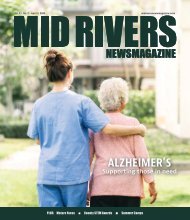West Newsmagazine 3-21-18
Local news, local politics and community events for West St. Louis County Missouri.
Local news, local politics and community events for West St. Louis County Missouri.
You also want an ePaper? Increase the reach of your titles
YUMPU automatically turns print PDFs into web optimized ePapers that Google loves.
50 I HEALTH I<br />
March <strong>21</strong>, 20<strong>18</strong><br />
WEST NEWSMAGAZINE<br />
@WESTNEWSMAG<br />
WESTNEWSMAGAZINE.COM<br />
Hunger Isn’t Seasonal;<br />
The Need Continues Year Round!<br />
Your generous donation provides low income<br />
families in <strong>West</strong> St. Louis County with:<br />
• Wholesome Foods<br />
• Financial Assistance<br />
• Summer Camp Opportunities<br />
• Career Mentorship<br />
• Scholarships<br />
• Holiday Programs<br />
Call to learn how you can receive Missouri Food Pantry tax credits for your donations and get back<br />
more than just the gratitude of helping your neighbors in need!<br />
(636) 861-2623 • www.circleofconcern.org<br />
Washington University scientists have developed an inexpensive way to transport<br />
blood and other lab samples without the need for refrigeration.<br />
health<br />
capsules<br />
By LISA RUSSELL<br />
Area scientists develop new<br />
method to transport lab samples<br />
Preserving the quality of lab samples<br />
as they are transported to and from testing<br />
facilities long has been a challenge. To<br />
provide accurate test results for patients<br />
who may live many miles from hospitals<br />
and labs, their blood or urine samples must<br />
be refrigerated throughout transport, which<br />
often is an expensive and difficult process.<br />
Using nanotechnology, a team of researchers<br />
at Washington University has eliminated<br />
that need for refrigeration. They have<br />
developed a new preservation technique that<br />
creates a protective shield around protein biomarkers<br />
in various types of samples. Using<br />
this method, which can be implemented at<br />
low cost, lab samples maintain 95 percent of<br />
their purity while providing accurate information<br />
to healthcare providers.<br />
The Wash U research, which recently<br />
was published in Chemistry of Materials,<br />
is the first to use an emerging class of<br />
nanomaterials, called metal-organic frameworks,<br />
to work with biological specimens<br />
such as blood, urine, serum and plasma.<br />
The research team plans to test this new<br />
method with other types of biomolecules to<br />
create more potential applications for both<br />
research and clinical settings, as well as to<br />
develop a kit that would allow patients to<br />
prepare their own samples to send to labs<br />
for testing. The team is working to patent<br />
the technology, and also intends to develop<br />
it into a product for the healthcare industry.<br />
CDC report shows worsening opioid<br />
crisis, particularly in Midwest<br />
The most recent Vital Signs report from<br />
the U.S. Centers for Disease Control and<br />
Prevention [CDC] shows that America’s<br />
opioid overdose epidemic continues to<br />
accelerate. The report, based on emergency<br />
department data collected in 45 states,<br />
found that the rate of suspected opioid overdoses<br />
increased nationwide by 30 percent<br />
from July 2016 through September 2017.<br />
The rate of overdoses increased for both<br />
men and women, among all age groups, and<br />
throughout all regions of the country; however,<br />
the increases varied by state, and were<br />
greater in urban than rural areas.<br />
Although all five U.S. regions designated<br />
by the CDC experienced rate increases, by<br />
far the largest was seen in the Midwest,<br />
with a 70-percent rise in overdoses – followed<br />
by the <strong>West</strong> [40 percent], Northeast<br />
[<strong>21</strong> percent], Southwest [20 percent] and<br />
Southeast [14 percent].<br />
Significant increases were seen in all<br />
states reporting in the Midwest, including<br />
Wisconsin [109 percent], Illinois [66<br />
percent], Indiana [35 percent], Ohio [28<br />
percent] and Missouri [<strong>21</strong> percent]. Men<br />
and women experienced similar increases<br />
in the overdose rate [30 percent vs. 24 percent].<br />
The problem also was spread fairly<br />
evenly among age groups, with the greatest<br />
increase of 36 percent seen among people<br />
ages 35-54.<br />
The report’s findings spotlight the need<br />
for better prevention and treatment efforts<br />
in emergency rooms and for greater access<br />
to evidence-based opioid use disorder<br />
treatments, according to CDC officials.<br />
“Long before we receive data from death<br />
certificates, emergency department data<br />
can point to alarming increases in opioid<br />
overdoses,” said CDC Acting Director<br />
Anne Schuchat, M.D. “This fast-moving<br />
epidemic affects both men and women,<br />
and people of every age. It does not respect<br />
state or county lines and is still increasing<br />
in every region in the United States.”<br />
‘I-talk’ may signal<br />
emotional distress<br />
Those people who always seem to make<br />
themselves the topic of conversation are<br />
not necessarily annoying, self-centered

















